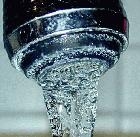New, cheaper method for extracting clean water

A mobile pilot system could make preliminary feasibility tests for
desalination easier and cheaper for developing countries.
The system — known as 'M3' — can test whether fresh water can be extracted
from almost any water source, say a team from the US-based University of
California, Los Angeles (UCLA).
It harnesses a popular desalination technique known as reverse osmosis, a
filtration process that forces water through a membrane, filtering out
impurities.
Desalination is often costly but the M3 system can cut costs. Normally, a
new static pilot plant must be constructed at every potential water source
both to test water quality and to assess strategies for pretreating water.
Pretreatment is needed to remove impurities before they pollute the reverse
osmosis membranes. These are costly to clean and replacing them means
shutting down desalination plants, Nidal Hilal, director of the Centre for
Clean Water Technologies at Nottingham University, United Kingdom, told
SciDev.Net.
M3's flexible and portable nature means that a country interested in
desalination could buy one system and use it to test all potential water
sources, says UCLA team leader Yoram Cohen — saving time as well as money.
Deepak Kachru, of Aquatech International's Indian subsidiary, welcomes the
system: "I am sure a mobile reverse osmosis system would be useful,
especially for a system provider like Aquatech, which requires the same
tests to be conducted at multiple sites."
Adel Sharif, director of the Center for Osmosis Research and Applications at
the University of Surrey, UK, told SciDev.Net: "Mobile pilot plants are
absolutely useful in developing countries wanting to use reverse osmosis to
test water quality."
"The M3 can fit into a standard cargo van with little effort," says Cohen.
"It can be used for a wide-range of brackish [a mixture of seawater and
fresh water] as well as sea water desalination. It produces up to about
5,000 gallons of water from seawater or up to about 8,000 gallons from
brackish water. This means that the M3 can readily be used in emergency
situations."
But Vincent Casey, technical support manager at international
nongovernmental organization WaterAid, says that the technology isn't
feasible for communities WaterAid works with. He said WaterAid doesn't
usually suggest reverse osmosis because it is costly, needs pre-treatment,
spare parts are hard to get locally, and plants needs expertise for
maintenance. Also, it doesn't usually address the issue of bringing water
closer to the home.
Nevertheless, Cohen and his team "absolutely" hope that when the M3 becomes
commercially available it will be affordable by developing countries. He
adds: "Our main goal is to make the process smart so that it can be used
even in areas where there is little expertise."
This article was reproduced with the kind permission of Science and Development Network.